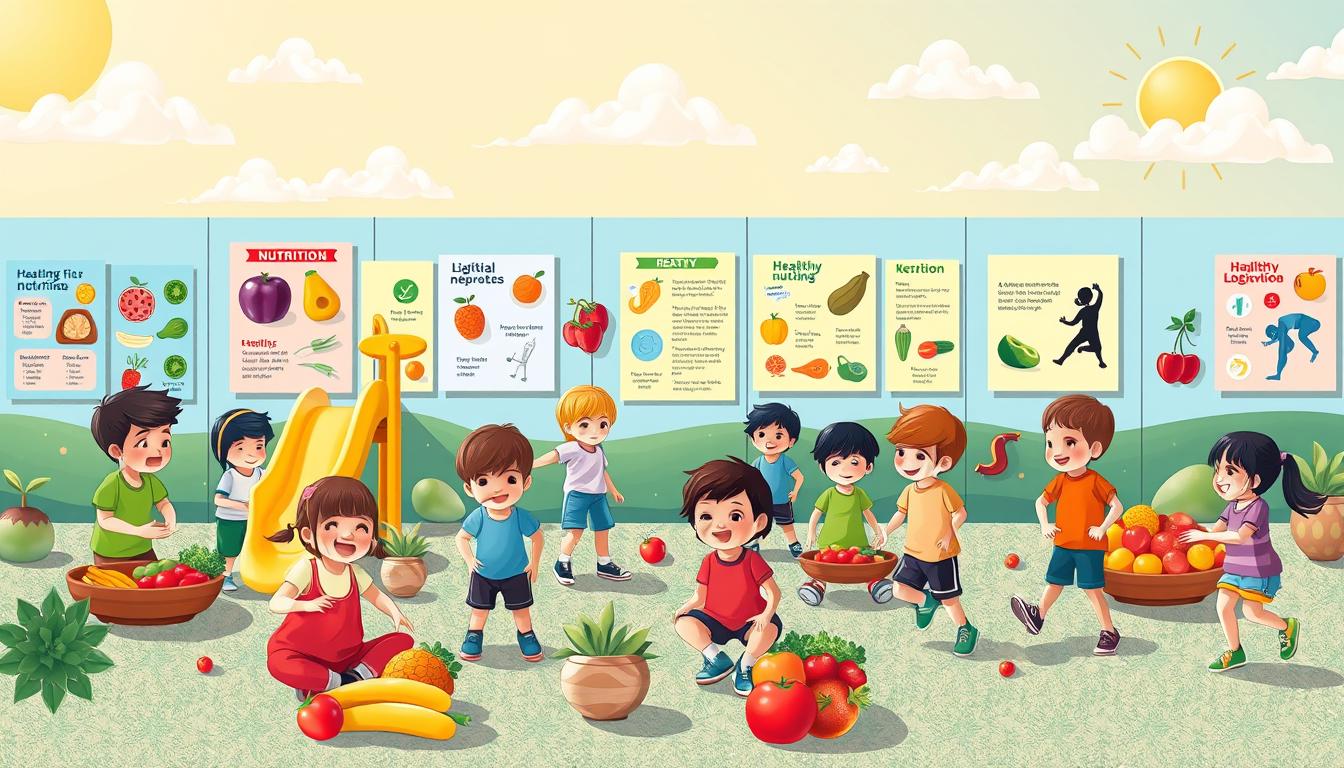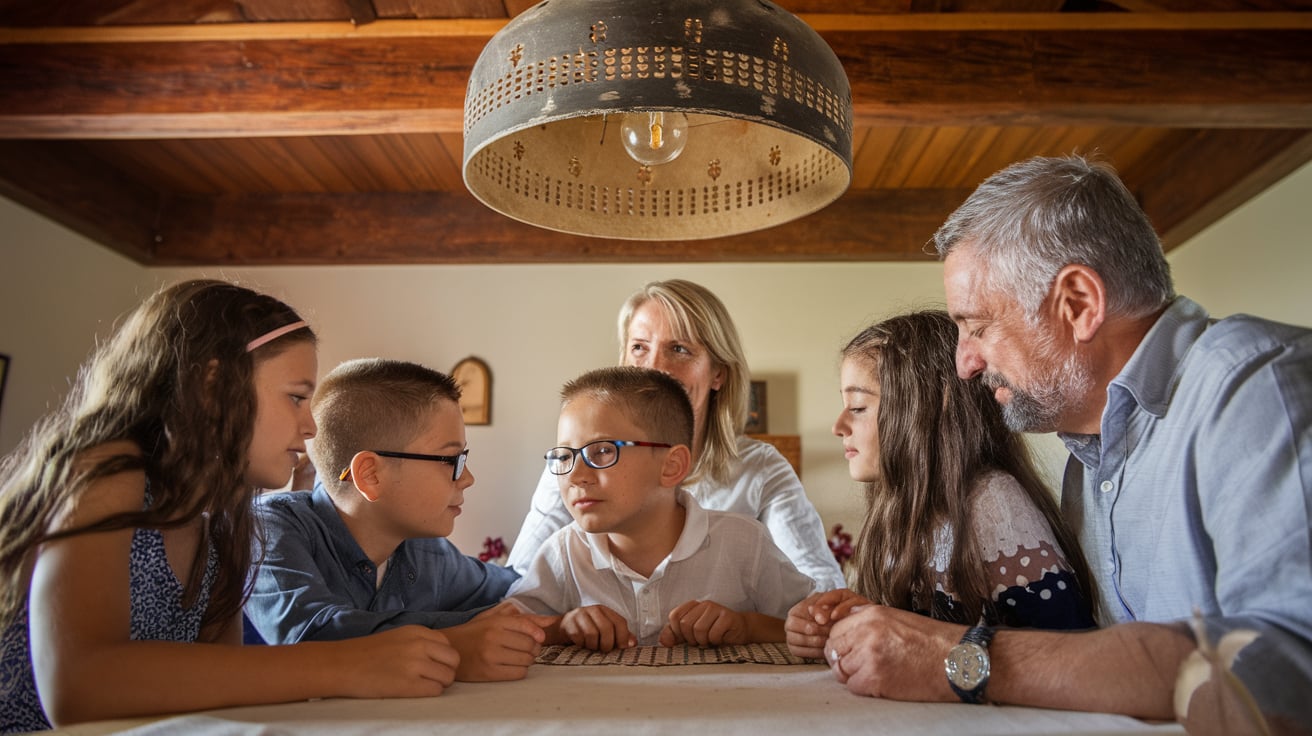Childhood obesity is a serious public health problem. It’s a topic that needs our urgent attention. It affects the health and future of our young people.
Child Obesity Hot Button
This article will explore the child obesity crisis deeply. We’ll look at its effects, possible solutions, and our shared duty to protect Australian kids’ health and happiness.
Key Takeaways
- The child obesity crisis in Australia is a growing concern with far-reaching health and social implications.
- Understanding the key risk factors and trends is crucial to addressing this critical issue.
- The physical, mental, and emotional impacts of childhood weight issues require a multifaceted approach.
- Collaborative efforts between families, schools, and communities are essential to instilling sustainable health habits in young Australians.
- Government policies and public health initiatives play a pivotal role in shaping a healthier future for our nation’s children.
Understanding the Child Obesity Crisis in Modern Australia
The rise in child obesity is a big worry worldwide, and Australia is feeling it too. It’s important to look at the numbers, what causes it, and how it affects kids’ lives and society.
Current Statistics and Trends
In Australia, one in four kids are overweight or obese. This is a worrying trend that matches what’s happening globally. The child obesity rate in America and other rich countries has also gone up a lot in the last ten years.
Key Risk Factors in Australian Youth
- Sitting too much and not moving enough
- Eating too much junk food and sugary snacks
- Being from a poorer background
- Genetics and hormonal issues
- Not getting enough sleep or good sleep quality
Social and Economic Impact
The pediatric overweight crisis in Australia is more than just health problems. It also affects society and the economy in big ways, including:
- More money spent on healthcare for obesity-related illnesses
- Less work done and less money made because of health issues
- Being teased or treated unfairly because of weight
- More inequality as it hits poor communities harder
Getting to know the full picture of child obesity in Australia is key to finding ways to fix it.
The Child Obesity Hot Button: Addressing the Growing Concern
In recent years, childhood obesity has become a major worry in Australia. The rates of kids struggling with weight have gone up, threatening their health. This has caught the eye of everyone, making it a critical issue that needs quick action.
Dealing with child obesity is urgent because of its wide effects. It not only harms their physical health but also affects their mental and social growth. As the problem gets worse, we need strong, all-around solutions to fix it.
Many groups, like the government, healthcare, and community groups, are fighting this battle. They’re working on school programs, public campaigns, and helping families. Their goal is to help kids stay fit and healthy.
But the fight against childhood obesity is ongoing. We need to keep working together to tackle the many reasons behind it. By doing so, we can help kids develop good habits and a healthy future.
“The child obesity epidemic is not just a health issue – it’s a societal challenge that requires a collective response from all sectors of our community.”
Physical Health Consequences of Childhood Weight Issues
The kids’ health emergency in Australia is growing. Childhood obesity is a big worry. It can harm kids’ health now and later on, making early intervention for obesity very important.
Immediate Health Risks
Children with obesity face many health problems. These include:
- Type 2 diabetes
- High blood pressure
- Asthma and respiratory issues
- Fatty liver disease
- Orthopedic problems
Long-term Medical Complications
Childhood obesity can lead to serious health issues later in life. These include:
- Cardiovascular disease
- Metabolic syndrome
- Certain cancers
- Sleep apnea
Impact on Physical Development
Being overweight can slow down a child’s growth. It can affect:
- Delayed motor skills and coordination
- Impaired bone and muscle growth
- Reduced physical activity and fitness levels
It’s vital to tackle the kids’ health emergency. We must act early to protect the health of Australian kids.
Mental and Emotional Impact on Young Australians
The childhood obesity crisis in Australia is more than just a physical issue. It also affects the mental and emotional health of young people. Struggling with weight can cause serious psychological problems. These problems can harm a child’s development and happiness if not treated.
One big worry is how it affects self-esteem. Kids who are overweight or obese often face bullying and stigma. This can really hurt their self-image and confidence.
Feeling left out and struggling to join in sports can make kids feel frustrated and sad. This can make their mental health even worse.
To tackle these problems, we need to support youth fitness challenges and active lifestyles. By helping kids enjoy being active, we can fight obesity and boost their self-esteem. This way, we can raise a generation of confident and happy young Australians.
“Addressing the mental and emotional impact of childhood obesity is just as important as tackling the physical challenges. By fostering an environment that celebrates and supports youth fitness, we can unlock the full potential of our young Australians.”
Role of Digital Technology and Sedentary Lifestyle
In today’s world, screen time is a big problem for kids. Young Australians are spending too much time on devices. It’s important to find a balance between digital activities and being active.
Screen Time and Physical Activity
Too much screen time can make kids less active. Studies show that kids who use devices a lot move less. This can lead to obesity and health problems.
Getting kids to exercise and play outside is key. It helps fight the bad effects of sitting too much.
Gaming Addiction Concerns
- Gaming addiction is a big worry for young Australians. It affects their health and mind.
- Playing games too much can make kids move less, sleep poorly, and feel lonely. This makes the problem of kids being inactive worse.
- Setting limits on gaming and encouraging kids to move can help. It reduces the harm of gaming addiction.
Digital Solutions for Health Tracking
While tech can make kids sit more, it can also help them be more active. Fitness trackers, apps, and games can track activity and motivate kids. They help kids stay on track with their health goals.
| Digital Fitness Tracker | Key Features | Benefits |
|---|---|---|
| Fitbit Charge 5 | 24/7 heart rate tracking Sleep quality monitoring Guided breathing exercises | Motivates users to reach their fitness goals Promotes better sleep and stress management Encourages a more active and balanced lifestyle |
| Apple Watch Series 7 | Activity tracking and goal-setting Personalized workout recommendations Mindfulness and meditation features | Helps users stay motivated and engaged in their fitness journey Provides tailored guidance for effective workouts Supports overall well-being through stress-reducing activities |
By using digital tech wisely, we can help young Australians be healthier. We can fight childhood inactivity and encourage active lifestyles. This will benefit them now and in the future.
Family Dynamics and Dietary Habits
The family environment greatly influences children’s eating habits and health. Nutrition education for families is key in tackling the growing problem of childhood weight management in Australia.
Research shows that parents’ views on food deeply affect their kids’ eating choices. Kids often copy their parents’ food habits. This makes the home a key place for learning about healthy or unhealthy eating.
- Involve children in meal planning and preparation to foster a positive relationship with food.
- Establish regular family mealtimes to encourage mindful eating and social interaction.
- Limit access to unhealthy snacks and sugary beverages in the home environment.
- Encourage physical activity and active play as a family to promote overall wellness.
| Healthy Habits | Unhealthy Habits |
|---|---|
| Balanced, nutrient-rich meals | Reliance on fast food and processed foods |
| Limiting screen time and sedentary activities | Excessive screen time and lack of physical activity |
| Regular family mealtimes and communication | Irregular or rushed mealtimes, minimal interaction |
Creating a supportive and health-focused family environment is crucial. Parents can greatly influence nutrition education for families and help manage childhood weight management at home.
“The family is the foundation of society. It is where we learn the values that guide our lives.”
TO WATCH THE VIDEO CLICK HERE
School-Based Interventions and Education Programs
Australia is fighting hard against childhood obesity, and schools are key. Schools across the country are launching new programs to help. These programs aim to make kids more active and healthy.
Successful School Initiatives
Australian schools are tackling childhood obesity with big programs. These include:
- Hands-on nutrition education, teaching students about balanced diets and the importance of making healthy food choices
- Engaging physical activity programs, such as dance classes, sports clinics, and interactive fitness challenges
- Partnerships with local health organizations to provide students and families with access to resources and support
- Strict healthy canteen policies, ensuring nutritious meal and snack options are available on campus
Physical Education Evolution
Physical education in schools has changed a lot. It now includes more than just sports. Students get to try out different activities like yoga and outdoor adventures. This helps them love being active for life.
Healthy Canteen Policies
| Healthy Canteen Policy Metrics | 2015 | 2020 |
|---|---|---|
| Percentage of schools with healthy canteen policies | 65% | 85% |
| Proportion of schools offering nutrient-dense food options | 72% | 92% |
| Student satisfaction with healthy canteen options | 63% | 82% |
Healthy canteen policies in schools are a big win. They make sure kids eat well. This helps them stay healthy and happy.
Australia is taking big steps to fight childhood obesity. Schools are leading the way with new programs. This is helping kids stay active and healthy.
Community Support and Resources for Families
Fighting childhood obesity is a big challenge, but community support is key. Families in Australia have many resources to help them live healthier. These resources guide them towards better lifestyles.
Community-based obesity prevention programs are everywhere. They team up healthcare experts, teachers, and community leaders. They offer workshops and exercise sessions to help families change for good.
There are also many resources for nutrition education. Health clinics, community centers, and schools run seminars and classes. They teach about meal planning and healthy shopping. This helps parents teach their kids to eat well.
- Community-based obesity prevention programs
- Nutrition education workshops for families
- Healthy cooking classes and meal planning guidance
- Support groups for parents navigating childhood obesity
- Collaborations between schools, healthcare providers, and local organizations
Working together, we can make a big difference. We can help families build healthy habits. This way, we can stop childhood obesity from spreading.
“When a community comes together to address a challenge like childhood obesity, the impact can be truly transformative. It’s not just about individual change, but about creating a culture of wellness that supports families every step of the way.”
Building Sustainable Health Habits in Youth
Helping kids develop healthy habits is vital for their future. We can do this by starting them with the right exercise, teaching them about food, and cheering them on. This way, we help them adopt habits that will last a lifetime.
Age-Appropriate Exercise Programs
It’s important to get kids moving in ways that fit their age. Young ones love playing games, dancing, and swimming. As they get older, they can try sports, strength training, and cardio to keep them active.
Nutritional Education Strategies
Teaching kids about healthy eating is crucial. We can use cooking classes, food pyramids, and fun lessons to show them how food affects their health. This knowledge helps them make better choices.
Positive Reinforcement Techniques
Positive feedback is a great way to encourage healthy habits. We can celebrate their achievements, give them rewards, and create a supportive environment. Doing things together as a family and building a community can also help.
By teaching kids the right way to exercise, eat, and stay motivated, we can raise a generation of healthy, active Australians. They will be ready to live a long, happy life.
| Exercise Program | Age Group | Key Benefits |
|---|---|---|
| Dancing | 3-8 years | Improves coordination, boosts mood, and fosters creativity |
| Strength Training | 9-12 years | Builds muscle strength, enhances bone density, and develops proper form |
| Cardiovascular Activities | 13-16 years | Increases endurance, improves heart health, and promotes weight management |
“Empowering children with the tools to build sustainable health habits is not just a responsibility, but a gift we can give them for a lifetime.”
Government Policies and Public Health Initiatives
The Australian government is tackling the pediatric overweight crisis head-on. They have launched various policies and health initiatives. These aim to fight childhood obesity and encourage healthy habits in young Aussies.
The Healthy Communities Program is a key government effort. It gives funding and resources to local councils. They use this to create more places for kids to play, plan cities for walking and biking, and teach about healthy eating and exercise.
| Government Policy | Key Focus | Outcomes |
|---|---|---|
| Healthy Food Partnership | Reformulating processed foods to reduce sugar, salt, and fat content | Improved nutritional profiles of popular food products |
| National Obesity Strategy | Coordinating cross-sector efforts to address obesity across the lifespan | Enhanced collaboration between government, industry, and community organizations |
| Active Kids Rebate | Providing financial assistance for extracurricular physical activities | Increased participation in sports and exercise programs among children |
While these efforts have shown promise, experts say more is needed. They suggest stronger rules on unhealthy food ads, better health lessons in schools, and more support for local obesity prevention projects.
“Tackling childhood obesity requires a comprehensive, whole-of-society approach. It’s not just about individual choices, but also the environments and systems that shape those choices.”
– Dr. Sarah Awan, Public Health Specialist
Conclusion
The issue of child obesity is a big problem in Australia today. It affects the health and happiness of our kids. We’ve looked at the numbers, the reasons behind it, and how it impacts our society.
We need everyone to work together to solve this problem. Families, schools, communities, and governments must join forces. By encouraging kids to be active and teaching them healthy habits, we can help them live better lives.
Education and new ways to help kids are key. We can give them the skills to make good choices. This way, they can grow up healthy and happy.
We must all act now to help our children. Together, we can make sure they have a bright future. Let’s work together to give our kids the best chance at life.
FAQ
What is the current state of child obesity in Australia?
Australia is dealing with a serious child obesity problem. The number of overweight and obese kids has gone up over the years. This issue is a big worry because it affects kids’ health and society.
What are the key risk factors contributing to childhood weight issues in Australia?
Several things contribute to child obesity in Australia. These include sitting too much, watching screens too long, eating unhealthy foods, and differences in wealth.
How does childhood obesity impact physical health and development?
Being overweight in kids can cause serious health problems. These include type 2 diabetes, high blood pressure, and breathing issues. It also raises the risk of heart disease and some cancers later on. It can slow down growth and development too.
What are the mental and emotional consequences of childhood weight problems?
Obesity in kids can hurt their mental health. It can lead to low self-esteem, feeling left out, and depression. It’s important to encourage kids to be active and have a positive view of themselves.
How can digital technology and sedentary lifestyles contribute to childhood obesity?
Too much screen time and sitting can make kids more likely to be overweight. But, technology can also help promote healthy habits and track fitness.
What role do family dynamics and dietary habits play in childhood weight management?
Family and home environment shape kids’ eating and lifestyle choices. Teaching families about nutrition and helping them adopt healthier habits is key to fighting childhood obesity.
What school-based interventions have been successful in tackling childhood obesity?
Schools are crucial in fighting child obesity. They can offer good physical education, healthy food options, and nutrition lessons. These efforts can really help kids stay active.
What community-based resources and support are available for families dealing with childhood weight issues?
There are many programs and resources for families dealing with childhood obesity. They focus on healthy living, nutrition education, and support for making positive changes.
How can families build sustainable health habits in their children?
Creating lasting health habits in kids needs a few things. These include fun exercise, good nutrition education, and positive encouragement. Starting early and focusing on long-term changes is essential.
What government policies and public health initiatives are in place to tackle childhood obesity in Australia?
The Australian government and health groups have set up many plans to fight childhood obesity. These include school programs, awareness campaigns, and community efforts. Working together and using a wide range of strategies is needed to tackle this issue.
TO EXPLORE MORE TOPICS CLICK HERE


